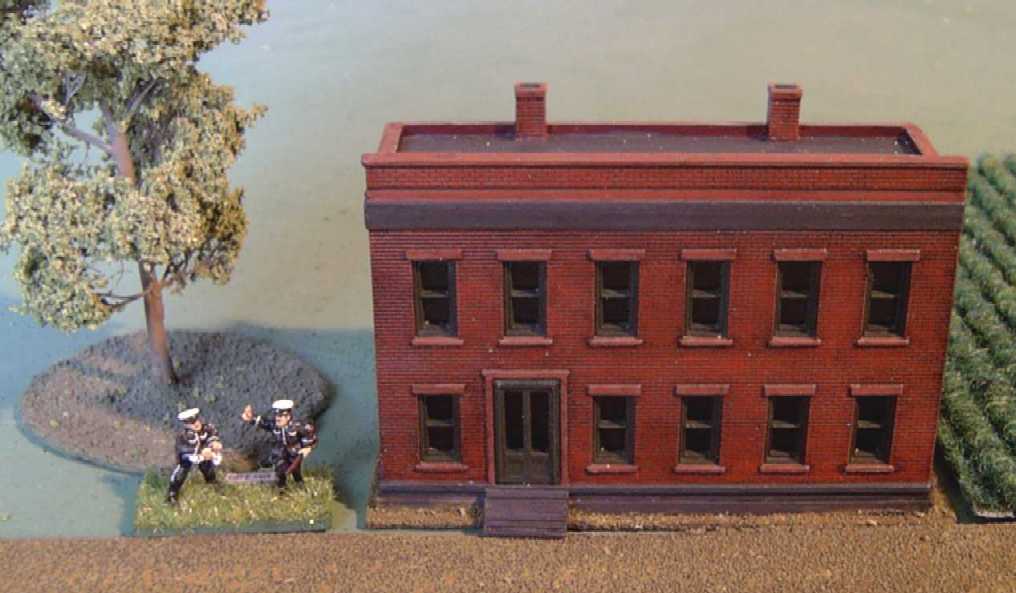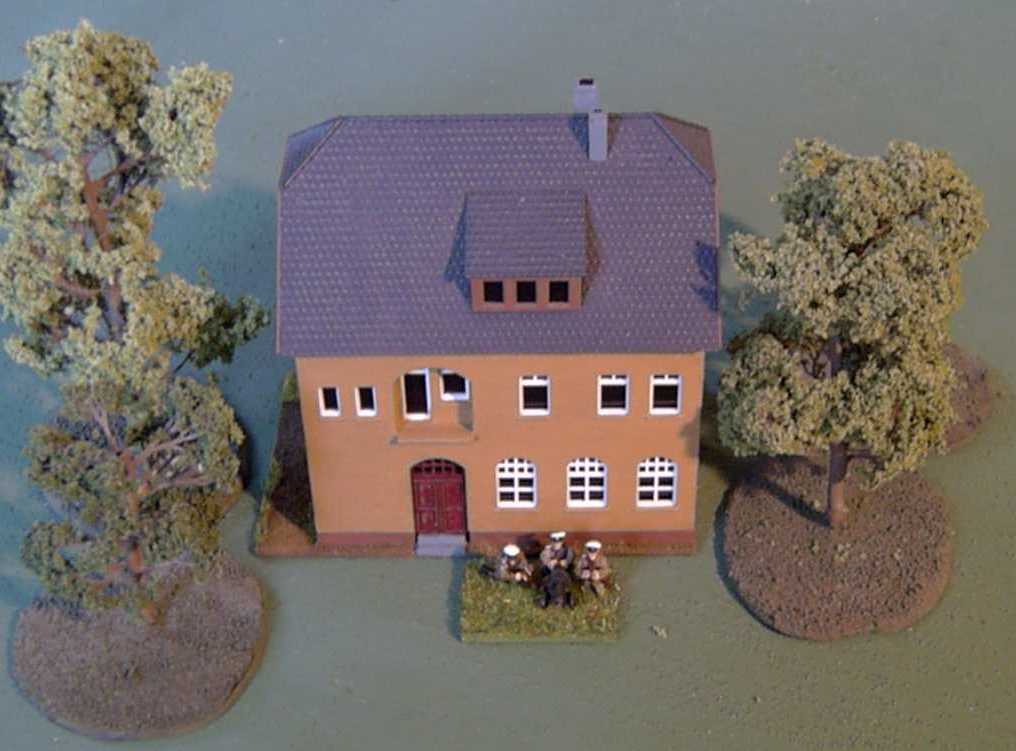
My Russian Terrain
The photos below are squeezed to fit onto the page, they will display larger if saved.
I really don't like most commercially available 15mm terrain because although it is correctly scaled for the figures it tends to take up too much space on the table. In particular, either the villages are too large in terms of ground scale or they contain too few houses to look like a village. Either way, items like churches tend to be huge. In any case, why should your houses scale to 15mm (i.e. approximately 1:100) when most tree models standing beside them are nowhere near that? (Work it out: a fairly ordinary tree, 20 metres tall, in true 15mm would stand some 20 cm high, and most trees are taller than 20 m.) Some people suggest using 1:300 scale terrain with 15mm, and I can see how that would work, but I wanted something that would look more aesthetically pleasing alongside 15mm figures.
So I went for N scale model railroad stuff. That meant I could easily purchase railroad track from the local hobby store and that there were loads of quality kits for the fiddly buildings (factories, churches etc). Allegedly N is meant to be 1:187 or thereabouts, but most of the stuff looks a lot bigger than that, and is just fine beside 15mm figures. I find the reduced size of the resulting villages on the table more than compensates for any oddities if you really examine up close the size of the people versus the size of the doors and windows (and it helps that Peter Pig tend to the small side of 15mm).
The disadvantages are that N scale can be fearsomely expensive and I would have to make my own smaller buildings, since model railroad people do not make 1920's Russian cottages. And once committed to such a path though you have to make all the stuff that scale, because it really looks stupid alongside normal 15mm stuff!

I tried desperately to find some commercial basic Ukrainian style peasant cottages that would mix with N scale, but nothing was close really. So in the end I resorted to casting my own in resin. Although a hassle, it wasn't particularly difficult and after the initial outlay it meant that I could cast up loads for very little, rather than having to skimp on buying just as many as my budget could afford (this is only a selection of the ones I made). In the end I made four masters, two very small and two medium sized cottages. I used spare windows from plastic kits, and the windows are the only tricky bit in such plain buildings. I also made two styles of thatched roof for each size, so that I could mix up the bases and roofs to give a bit more variety. Another advantage of separate roofs is that if I make northern style log cabins I will already have them half made.

I find that the figures look OK beside them, though getting through the doors would be a squeeze. (Remember that the figures look tall in this shot because they stand on a base.) As you can see in this picture, the height of the buildings is at a different scale from the width and depth but from a high angle, such as over a game table, you really don't notice that. It allows the doors and windows to look right while keeping the building's footprint to a minimum (even Russians would struggle to live in a cottage this small).

This is a factory straight from a plastic kit. Even if someone made a model this good in 15mm it would take a huge chunk of the table, for no advantage in game play. The chimney is a pain though, always getting in the way!

This is a DPM kit. I like them because the windows come cast in so that there is no fiddling about, one just slaps the sides together for the simple ones. However, I tend to chop most kits down a bit anyway either to reduce their footprint, remove fiddly detail or to make them less tall and prone to being knocked over on the table. This one started life as a three storied building.

This is what I use as the grand house of some noble family, a "manor" in the Baltic states.
The trees were from Realistic Modeling Services. They are indeed realistic, but the price tag gives one reason to think twice about whole forests of them. The house is way too big in terms of ground scale, but what's the point of having an unimpressive manor?

I made this windmill, largely out of coffee stirrers. (Gee that sounds corny! I used them because they are stronger than balsa wood, not because I'm cheap.) The only difficult part was finding a source of something strong to make the fiddly bits of the vanes. Eventually I got some HO brass window pieces (thanks, Zippy!) which, being metal, are strong enough to take the inevitable knocks.

It doesn't photograph so well, being gleaming white, but this is my Orthodox village church, scratch built because I could not find a kit. Basically built in cardboard; the windows are spare from a plastic kit; the dome is a table-tennis ball with modeling paste to make it onion shaped. Protestant and Catholic church kits are plentiful.
Time Cast
Since I wrote the above, I have bought some of Time Cast's 10mm Russian terrain. Two wooden houses that will paint up nicely as town houses for me, but are equally useful as northern village houses, and a simple wooden church that I will probably use as a school-house or similar, since I already have enough churches. All good quality stuff (as their reputation would suggest).
Looking at their range I think that N scale/10mm is quite achievable now.
